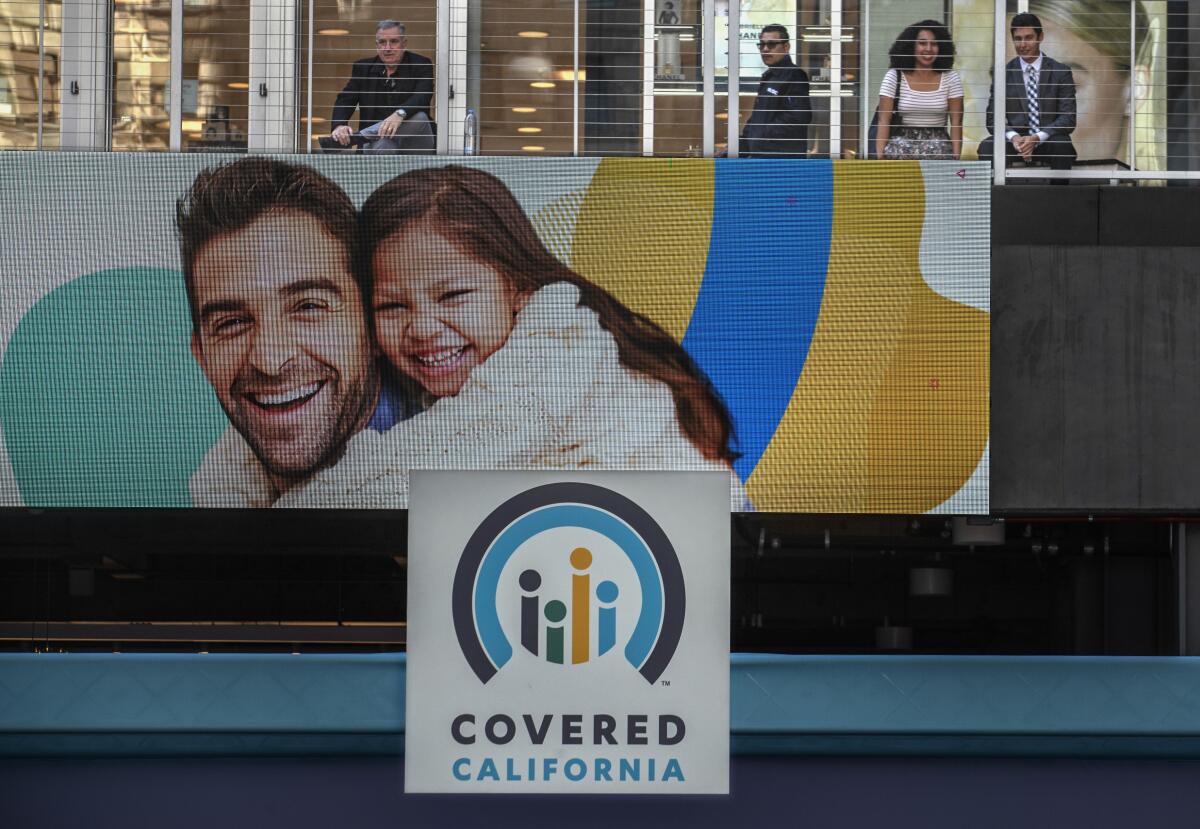Covered California open enrollment begins. What to know about signing up, subsidies and more

- Share via
The 2010 Affordable Care Act made it possible for millions of uninsured Americans to gain health coverage through new state marketplaces. And when open enrollment for 2023 begins today, even more families may be able to gain coverage, thanks to a recent change in the ACA rules.
According to an estimate from Covered California, the ACA marketplace in this state, the new rule could benefit 615,000 residents, most of them women and children. That’s on top of the 1.7 million who already obtain policies through Covered California.
At issue are federal premium subsidies and something called the “family glitch.”
The ACA’s subsidies limit health insurance premiums to a percentage of your household’s annual income. The less you earn, the lower the percentage you’ll have to pay — in fact, you could obtain coverage with no monthly premiums if your income is near the poverty line.
The subsidies, however, aren’t available to people who can sign up for affordable “minimal essential” coverage through an employer’s health plan. That’s roughly half the U.S. population.
One of the few exceptions to this prohibition is for workers who would have to pay more than 9.12% of their income next year to get coverage at work. Under the feds’ definition, such coverage isn’t “affordable.”
Covered California
Open enrollment basics
Covered California is the state’s Affordable Care Act health insurance marketplace.
The open enrollment period is Nov. 1, 2022, to Jan. 31, 2023.
Fill out an application or find someone to help you with the process at coveredca.com.
The Internal Revenue Service, however, declared in 2013 that the affordability test applied only to the cost of an individual policy. If adding coverage for your spouse or your kids pushed the cost of your family policy over the affordability limit, that didn’t matter — you weren’t eligible for premium subsidies.
In mid-October the IRS finalized a rule that removes this glitch, enabling workers to obtain subsidies for family coverage if it would cost more than 9.12% of their income to sign everyone up for their employer’s health plan. Although some critics say the new rule violates the ACA, some consumer advocates and members of Congress counter that the IRS’ original rule misread the intent of the law.
Jessica Altman, Covered California’s executive director, said the issue for many workers in the state is that their employer will help pay for their policy, but not for their spouse’s and children’s coverage.
According to estimates by UCLA and UC Berkeley, Altman said, almost half a million Californians have employer-sponsored coverage that is less affordable than what they will be able to obtain now on Covered California. An additional 87,000 Californians who could be helped by the new rule are uninsured today, and about 35,000 have policies that aren’t currently subsidized.
For more information on how the change will affect you and how to enroll in Covered California, read on.
A stolen wallet precipitates a reporter’s years-long fight against identity thieves — and a system that doesn’t care and won’t help.
Am I eligible for premium subsidies?
The answer depends on your employer, your income and the amount you’d have to spend for coverage, as well as the number of people in your household.
The first question is whether you can obtain comprehensive coverage — that is, a policy that includes 10 essential health benefits — from your employer that’s affordable. As noted above, this translates to a policy that costs less than 9.12% of your household modified adjusted gross income. That’s all the taxable income you report on your federal return, plus certain amounts that were deducted or excluded (such as interest on student loans).
Most employers’ health plans are affordable for their workers because employers pay most of the bill. Nevertheless, workers pay a significantly higher price for family coverage than individual coverage. According to the Kaiser Family Foundation’s latest survey, employees pay $1,327 a year on average for individual coverage and $6,106 for family policies.
If your employer’s premiums for both individual and family coverage aren’t affordable for you, your entire household is eligible for subsidies. And under the Inflation Reduction Act, the most you’ll have to pay for the standard “silver” plan is 8.5% of your modified adjusted gross income. The subsidies will cover the rest.
(You can sign up for a different level of coverage than what you’d find in the silver tier, which is designed to cover 70% of projected medical expenses. The amount of subsidy you’ll receive, however, is always based on the price of the second-lowest-priced silver plan in your region.)
If your employer’s premiums are affordable for individual coverage but the family premiums are not, only your spouse and kids will be eligible for subsidies through Covered California. So if you sign up your whole household for family coverage at Covered California, you’ll be legally responsible for the unsubsidized cost of your portion of coverage, which would probably be considerably more expensive than if you signed up for a separate, individual policy at work. Your family members’ cost will still be tied to a percentage of your household income, up to 8.5%.
According to James Scullary, a spokesman for Covered California, “90% of Covered California enrollees receive financial help, which covers an average of 80% of their monthly premium. As a result, two-thirds of our consumers can get comprehensive coverage for $10 or less per month.”
For an unofficial estimate of how much help you might receive from Covered California, check out the online calculators provided by the Kaiser Family Foundation and Healthinsurance.org.
(If your household income is at or below 138% of the federal poverty level, Covered California will help you enroll in Medi-Cal instead of a private insurance plan. For a single person, the income cutoff is $18,755; for a family of four, it’s $38,295.)
The federal government plans to forgive up to $20,000 in student loan debt for millions of Americans. Here’s everything you need to know.
How do I enroll?
You can sign up online at coveredca.com. The website also provides links to applications in 12 languages that you can print out and mail to the agency.
Alternatively, there are more than 11,000 insurance agents who can provide in-person help, as well as enrollment counselors. County social services offices can also bring you up to speed on your options. Covered California’s site has directories to help you find any of these resources.
Open enrollment ends Jan. 31. After that, you will not be able to obtain a policy through Covered California unless you lose your employer coverage, get married, move, or experience some other significant change in your circumstances.
Do I have to carry insurance? In California, every member of your household must be insured for at least nine months of the year. If you go uninsured, you’ll face a penalty of at least $850 per adult and $425 per dependent child younger than 18; the amount is higher for households with higher incomes. The state enacted the mandate after the federal government repealed its penalty for noncompliance, reasoning that it would motivate younger, healthier people to sign up for coverage. It also provides exceptions to the mandate for several different groups, including Californians who don’t make enough money to pay income taxes, whose premiums would be classified as unaffordable, or who are members of federally recognized American Indian tribes.
What if I’m not a U.S. citizen? Under the ACA, only citizens and people residing lawfully in the U.S. can purchase subsidized coverage through the state marketplaces. However, according to Covered California, if your child is a citizen and you are not, you can apply for subsidized coverage for your child without affecting your immigration status or your ability to become a permanent resident or citizen.
What information do I need to provide to enroll?
- Social Security numbers for applicants who are U.S. citizens, or proof of legal residency for noncitizen applicants.
- Details on each member of the family’s income and employment.
- Information from your federal tax forms, including the names of the person listed as the head of your household and the dependents claimed.
- Information about the employer-supplied health insurance available to any family member.
What if I already have a policy through Covered California? In that case, Covered California will renew your policy automatically if you take no action, assuming your insurer is still offering it. But that’s a risky choice if your household size, income or address has changed, which could alter the amount of subsidy you should be receiving. Under federal law, once you start receiving subsidies, you’re obliged to report such changes within 30 days (or within 10 days if you’re in Medi-Cal). If your subsidies aren’t adjusted and you receive too much aid, you may have to pay the difference back on next year’s taxes.
The new California ‘tax refund’ isn’t really a tax refund. But what is it? The uncertainty is why the taxability question is hard to answer.
Are premiums higher this year?
Altman, of Covered California, said premiums for 2023 are 5.6% higher on average statewide than they were this year, which is a larger bump than in the recent past. That’s in line with a national trend of higher increases; according to Kaiser Family Foundation, the average increase in the benchmark premium is about 4% nationally.
“Recent years were not normal years” because of the pandemic, Altman said; counterintuitively, people sought less care from their doctors, which led premiums to hold steady or even drop. Even including next year’s projected increase, she said, premiums have gone up only 2.3% on average over the last four years.
That’s well below the national average, Altman said, thanks in part to Covered California negotiating for better rates and aggressively marketing to state residents, which has helped attract a large and comparatively healthy group of enrollees. But she added, “The healthcare system is not immune to increases in costs occurring more broadly across society.”
The ACA’s subsidies increase when premiums increase, so the vast majority of Covered California’s customers will feel little of the pain caused by health cost inflation. Bear in mind, though, that those subsidy increases in the Inflation Reduction Act are set to expire in three years unless Congress renews them.
About The Times Utility Journalism Team
This article is from The Times’ Utility Journalism Team. Our mission is to be essential to the lives of Southern Californians by publishing information that solves problems, answers questions and helps with decision making. We serve audiences in and around Los Angeles — including current Times subscribers and diverse communities that haven’t historically had their needs met by our coverage.
How can we be useful to you and your community? Email utility (at) latimes.com or one of our journalists: Jon Healey, Ada Tseng, Jessica Roy and Karen Garcia.
More to Read
Sign up for Essential California
The most important California stories and recommendations in your inbox every morning.
You may occasionally receive promotional content from the Los Angeles Times.














